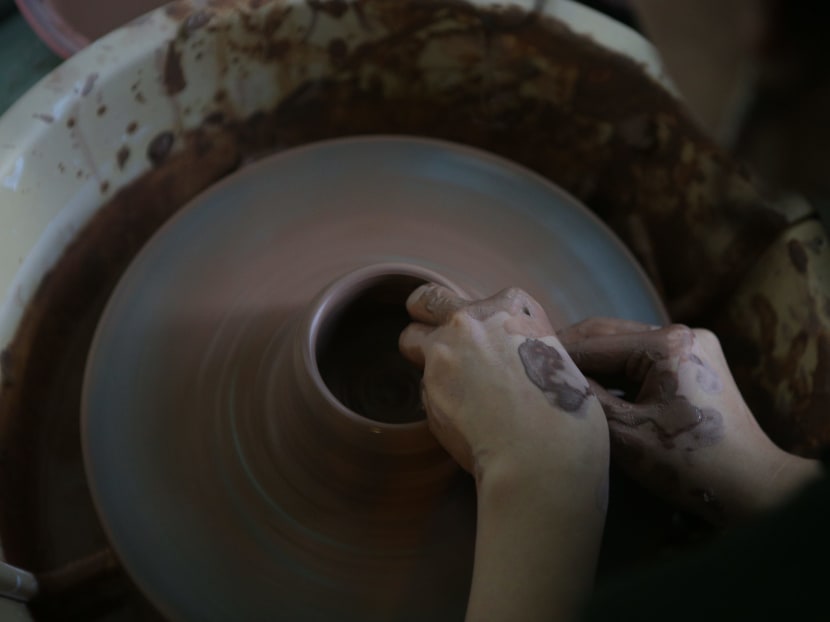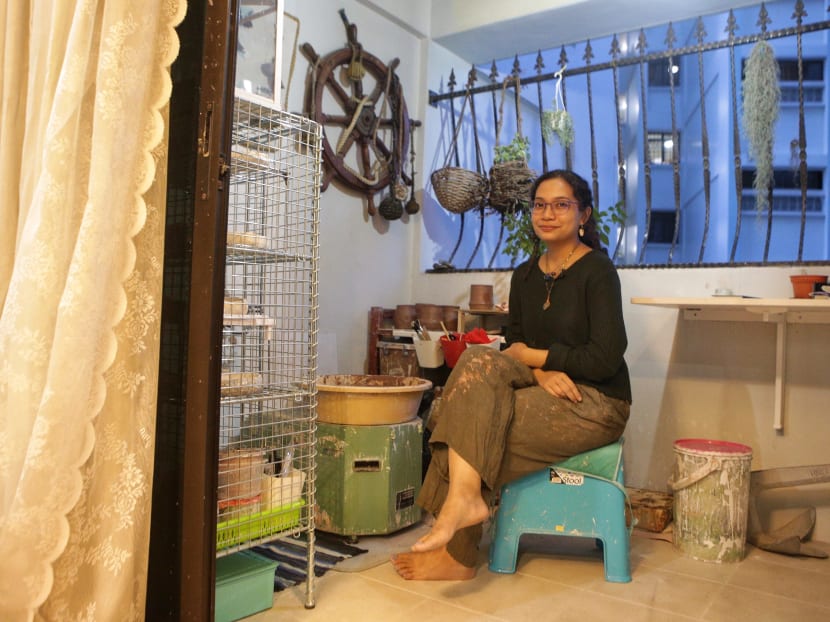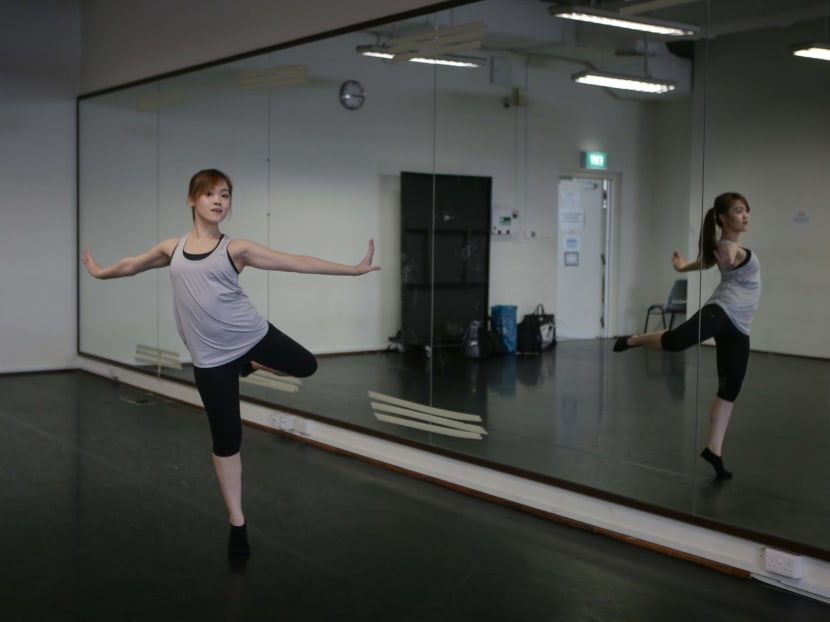The Big Read: For artistic millennials, making a living out of the arts is a craft in itself
SINGAPORE — While young artists in Singapore continue to face hurdles in pursuing a full-time art career, improvements to the arts scene here in the last 10 years have created more opportunities for them to follow their passions.

While young artists in Singapore continue to face hurdles in pursuing a full-time art career, improvements to the local arts scene in the last 10 years have created more opportunities for them to follow their passions.
SINGAPORE — Unlike a typical office worker, Mr Ben Loong leads a life off the beaten track.
From 9pm to 3am every day, the 30-year-old plies the roads as a Grab driver.
After getting some shuteye, he usually heads down to art galleries around the island to do odd jobs, such as painting and partitioning walls.
Some days, he also spends time working on art projects in these galleries. For instance, he spent the last month at Pearl Lam Galleries at Gillman Barracks working on his art exhibit, which involves using industrial material such as Gypsum plaster and resin to form an arrangement of tiles.
His work, which seeks to question material culture and value systems by recontextualising industrial objects, is among those to be featured as part of the upcoming Singapore Art Week’s Art After Dark series. The seventh edition of Singapore Art Week, which runs from Jan 19 to 27, will feature art installations and exhibitions across Singapore. The public will also be able to attend a series of art workshops, talks and film screenings throughout the week.
Mr Loong earns up to S$400 a month as a Grab driver to supplement his income from his art. While he makes just enough in total to cover his rent and expenses, he said that the sense of satisfaction in seeing his work up on a gallery wall keeps him going.
“When I studied in Lasalle College of the Arts, we would go to art galleries. It was inspiring to see the grandeur of the artwork on the wall. It makes you want the opportunity to be in that kind of position,” said Mr Loong, who took part in three exhibitions last year.
Mr Loong’s experience is not unique among artists in Singapore. Ceramic artist Ummu Nabilah, 24, returns home from her day job as an art teacher in the evenings, only to stay up till 2am working on pottery. She makes a few hundred dollars in profit from the sale of each batch of 15 pottery items, with each item costing up to S$30.

The profit is just enough for Ms Ummu to invest in the materials that she needs for her next batch of pottery. She maintains that as long as she works hard enough, and if she manages her money well, she will eventually be able to focus fully on her ceramic art career.
Industry experts and veterans whom TODAY spoke to said that while it remains very difficult for young Singaporeans to pursue artistic careers full-time, the arts scene has improved over the last decade, with more opportunities for artists to sustain themselves financially.
Government efforts to increase public participation in the arts, the advent of technology and a more supportive public attitude have also contributed towards a better working environment for Singaporean artists.
In October last year, Ms Grace Fu, Minister for Culture, Community, and Youth, announced the launch of Our SG Arts Plan, which laid out the focus areas for Singapore’s literary, performing and visual arts sectors from 2018 to 2022.
Ms Fu said the plan would allow the Government to provide better support for arts professionals and make the arts more accessible to all.
The Our SG Arts Plan builds on the Arts and Culture Strategic Review released in 2012, which detailed the arts and cultural landscape for Singapore until 2025. The plan aimed to develop “a nation of cultured and gracious people, at home with our heritage, proud of our Singaporean identity”.
Since the launch of the review, the National Arts Council (NAC) recorded a high of nearly 6,000 non-ticketed performing arts activities in 2016, a five-year record attendance of over 9.2 million at these activities, and more than 5.1 million visitors to museums and heritage institutions. The NAC said that S$300 million was pumped into the culture sector between 2012 and 2017.
BUILDING AN ARTS NATION
Apart from these two road maps for the arts scene, the Government has also introduced several initiatives over the last decade to raise the profile of the arts in Singapore, such as launching the School of the Arts (Sota) in 2008.
As the first pre-tertiary arts school in Singapore, Sota’s programme allows students to take one arts subject, in addition to the usual academic subjects taught in mainstream schools.
At the end of their six years, students graduate with an International Baccalaureate diploma.
However, it was reported in May 2017 that only three in 10 Sota graduating students went on to pursue arts-related university courses. An article from The Straits Times raised questions about the effectiveness of Sota’s programmes in preparing students for a career in the arts.
At that time, Ms Lim Geok Cheng, Sota’s principal then, commented on the lack of graduates going into arts-related courses by noting that its students continued to remain involved in the arts, regardless of the courses they chose.
While Sota’s latest enrolment figures are not available, the school’s student population had grown from just under 1,000 in 2012 to 1,120 in 2016.
The steady increase in Sota’s enrolment over the last few years shows that while the jury is still out on the success of its programmes, there is still a demand for an arts-oriented education programme in Singapore.
Several Sota graduates told TODAY that the school’s curriculum had broadened their minds.
For performer and music composer Amni Musfirah, 24, Sota had helped her to develop “a good sense of who I want to be, what I want to do and what do I want to achieve”.
“Many people outside of Sota thought we couldn’t succeed because we were just doing ‘arts’ and had ‘no brains’. Sota taught me the importance to believe in ourselves and trust that our skills will pay off,” said Ms Musfirah, who was part of the school’s pioneer batch of graduates in 2012.
Mr Pavethren Kanagarethinam, 21, who graduated from Sota in 2016, said that its broad educational framework allowed him to consider non-arts related careers, such as those in the sciences and humanities. However, he decided to remain in the arts sector following his graduation, because his percussion-playing skills had improved under the tutelage of his Sota music instructor and he remained passionate about music. He has since applied for several music production-related university courses to continue a career in music.
Outside of the education sector, the Government has also made efforts to increase Singaporeans’ participation in arts events — with mixed results.
The 2017 Singapore Cultural Statistics Report showed that the number of tickets sold for performing arts events dipped from 1,562,404 in 2015 to 1,398,857 the next year. In 2016, 2,809,708 people attended a non-ticketed art performance, a jump of about 27,770 people from the previous year. The number of visitors to national museums and heritage institutes also increased by nearly 1,370,000 between 2015 and 2016.
At the same time, the NAC recorded an overall drop in Singaporeans’ engagement in the arts within the same period. In its latest Population Survey on the Arts released in 2017, the NAC recorded a 24 per cent drop in arts attendance from 2015 to 2017. Participation in the arts also dropped from 28 per cent in 2015 to 22 per cent in 2017.
Despite the mixed results in improving Singaporeans’ participation in the arts, the Government has continued to be generous in its funding. The 2017 Cultural Statistics Report stated that an estimated S$412.8 million in funding was set aside the previous year for arts and heritage.
Donations to arts and heritage causes had more than doubled from S$29.7 million in 2013 to S$61.3 million in 2016.
THANKS FOR THE GRANTS BUT…
Many artists approached by TODAY acknowledged that the Singapore Government is a lot more generous than those in many other countries in the level of funding that it has set aside for the arts sector, and they are grateful for it.
Video artist Kray Chen, 31, the recipient of the NAC’s Young Artist Award in 2017, said that he was a beneficiary of the council's funding. “There are only a handful of countries in the world that fund artists at an international level. We are very lucky to have a well-funded system. While we could lose out on freedom of expression, Singaporean artists have definitely gained on a practical level.”
However, some artists have expressed concerns over the stringent criteria to qualify for NAC grants and the key performance indicators (KPIs) that they have to meet.
Mr Chen said that the administrative and bureaucratic process imposed on artists to account for huge amounts of funding could be a “daunting” task. “The artist has to wear so many hats. He has to hire an accountant or be his own accountant, his own marketer and his own administrator.”
The NAC requires artists who receive funding between S$25,000 and S$100,000 to provide a certified statement of accounts by a registered accountant. Grants above S$100,000 must be independently audited by a registered public accountant.
Some artists also feel that the KPIs imposed by the NAC could run counter to their objectives. Those who receive certain NAC grants have to complete self-evaluation forms which ask for information such as the total number of people who have attended the art event and the total number of tickets sold.
Mr Chen said: “If you have to count the number of people who attended an event or write a report about what participants have learnt from the event to justify the impact of the artistic work, then that is a problem… Are we looking at a numbers game or are we actually assessing the art’s social impact?”
For him, an art project is more successful if 10 people see it and understood it deeply, rather than having 100 people see it but do not understand the project.
In response to TODAY’s queries, the NAC said that self-evaluation reports were to help artists take stock of what they have accomplished through the course of their project. Subsequent grant applications by artists would be assessed based on the strength of their project proposals.
Mr Kamil Haque, founder and artistic director of Haque Centre of Acting & Creativity, said that while arts grants in Singapore are much higher and more accessible to artists compared to the United States, the red tape that artists have to surmount to receive those grants make it “onerous” for them to even start off.
This makes it difficult for young artists to sustain their interest and pursue the arts full-time, said the 36-year-old, who had spent eight years in Los Angeles learning and teaching acting before returning to Singapore.
Recounting her own experience, Ms Ummu said that she had unsuccessfully applied for an NAC grant when she first started selling her ceramic pieces.
According to Ms Ummu, to qualify for the grant, the artist needed to have a background in art exhibitions, and to justify how his or her art would benefit Singapore.
As a fresh graduate from the Nanyang Academy of Fine Arts (Nafa), Ms Ummu said that she was unable to meet the requirements, which seemed to favour more established artists. “They ask you for a lot even before you start,” she said.
The NAC told TODAY that grant criteria are developed by the council to ensure that projects supported the aims of the grant.
Mr Kok Heng Leun, artistic director of Chinese-language theatre company Drama Box and former Nominated Member of Parliament, called for an overhaul in approach towards how the Government views arts funding. Referring to funding caps by NAC, Mr Kok said that grants are issued to artists with a “return of investment” thinking process, where they are expected to fund a certain percentage of their work in proportion to the grants that the NAC extends to them.
NAC grants are subject to funding caps. For instance, artists who apply for NAC’s Participation and Presentation grant receive funds of only up to 50 per cent of the project’s budget.
Mr Kok urged the Government to view the arts as a public good and increase the profile of the arts in national funding. “When you subsidise something because you view it as a public good, it is because you see it as important and good for every human being… We need to change the mindset that art is just to beautify our surroundings. Art is the thing that gives you sanity and comfort. Art is what gives you imagination and creativity. So it is a necessity.”
SHIFTS IN TECHNOLOGY, ATTITUDES
Despite these concerns, industry players acknowledged that broader changes in society have created more opportunities for young artists to pursue their careers.
Major technological changes in the past 10 years have opened up a multitude of platforms for artists to showcase their works.
For actress Oon Shu An, 32, the Internet has allowed her to reach out to a global audience, with even foreigners recognising her when she travels overseas.
“Now I can speak for myself and have a direct channel with people who want to follow me,” said Ms Oon, who is the host of webshow series Tried and Tested. “It lets me reach a larger audience.”
Like Ms Oon, Ms Ummu has been able to expand her market overseas through social media. While Singaporeans come to know of her ceramics work through art markets here, Ms Ummu’s Instagram page allows her to connect with overseas buyers as far as the United States.

Through her Instagram account, she is also able to exchange ideas with overseas-based ceramic artists, allowing her to improve her craft.
The Internet has also changed the way consumers buy art. The Hiscox Online Art Trade Report 2018 found that the online art market was worth an estimated US$4.22 billion, an increase of 12 per cent in the past year.
The Artling’s director, Ms Kim Tay, said that being an online gallery allowed it to reach a broader audience, regardless of geographic location. It also allowed its artists and designers to gain exposure beyond their own countries.
“In the past five years, we’ve definitely seen a growth in people being willing to buy artworks online. We try to give our customers as much information as possible about all the artworks on our website, and our augmented reality feature on our iOS app allows customers to visualise how an artwork will look in their space in real-time.”
She added that while online galleries could not replicate the experience of viewing an artwork in real life, they complement physical galleries by providing them with an access to a different audience.
Besides technology, the rise of the gig economy has created more opportunities for artists to find alternative sources of income.
From driving a private-hire car to part-time teaching, almost every artist interviewed by TODAY holds more than one job — as a safeguard against the irregularity and, in some cases, the low pay of the projects they undertake.
Mr Chen said that while he receives an artist fee for exhibitions, it is usually a nominal sum. In some cases, he has even had to dip into his own pocket as the amount did not cover the cost of the art project.
However, he said that his part-time teaching stint at his alma mater Lasalle helps to supplement his income. While Mr Chen said that ideally, he would like to sustain himself through his art alone, his alternative income stream helps to take his mind off his financial burdens and allows him to concentrate on his art work when he receives projects.
For freelance performer Michelle Ler, 23, the biggest struggle in pursuing a career in the arts is the instability of it all.

Unlike her friends from other universities who settled into one job after going through multiple interviews, the Lasalle graduate described her artistic career as “a never-ending job interview”. “You get a job. It lasts from a few weeks to a month, and then it’s the same cycle again.”
However, she said that her income from her part-time job as a dance instructor gives her some financial comfort. She also creates her own work by staging shows during lull periods in the industry.
Despite the financial obstacles, several industry experts pointed out that the shift in societal attitudes has created a more favourable environment for younger artists to pursue their careers.
Lasalle’s provost, Dr Venka Purushothaman, said that with Singaporeans becoming better-educated and more well-travelled, they have an increasing desire to embrace the arts.
Over the last 15 years at Lasalle, he has seen more young people committed to engaging in the arts. He is also heartened by the support shown by parents.
“In the previous generation, parents would have questioned their child’s participation in the arts. However, the current generation of parents fully support their child’s pursuit of their passion.”
Dr Purushothaman’s observations reflect the rise of “new-generation parents” who are willing to let their children follow their passions, so long as they are happy.
One such parent is Ms Ummu’s mother, 46-year-old Rosnita Ninggal. Explaining why she had urged Ms Ummu to join Nafa, Madam Ninggal said: “When I was young, my parents put many restrictions on me. I did not want that for my own children. I want my kids to pursue any interest as long as they are responsible and know exactly what they want in life.”
For filmmaker He Shuming, 33, his then civil servant father and housewife mother were concerned about his decision to take up filmmaking. To assure them, Mr He worked on film sets to earn pocket money in his early years to convince them that he would be able to survive in the industry.
“My parents could see that I was happy and they gave me the space to do what I thought I could be good at.”
His father, Mr Ho Soo Hoon, 69, said that while he was initially concerned that Singapore’s market was too small for his son to pursue filmmaking, he eventually realised that there were opportunities for his son to earn a living, such as through directing television advertisements.
While he still has some concerns over his son’s “unpopular” career choice, such as the long hours, Mr Ho expressed confidence that his son would be able to survive in the industry for the long term.
Painter Eric Chan, 44, also said that greater awareness of the arts in Singapore means that younger artists are able to receive more support from their families. This has allowed young artists to pursue their passion with fewer concerns.
“They can just go in and do it. They don’t have to worry so much about whether they are going to survive,” said Mr Chan.
KEEPING THE FIRE BURNING
“Naïve”, “impulsive”, “passionate”. These were some of the words bandied about by several young artists to explain why they decided to pursue the arts as a career.
While they acknowledged that the realities of life, particularly with respect to financial stability, had made it very difficult for them to continue in the field, they had also found ways to make ends meet, and would continue to find ways to do so.
For Mr Loong, quitting is not an option. “Choosing this path, you have to be able to see yourself doing it for the rest of your life. If not, there is no point.”
“To want to keep pursuing art, you need to live in this illusion to keep this fire burning. If you keep thinking about money, you are more likely to quit your dream.”
Mr Loong said that his aim as an artist is to achieve a regular stream of opportunities, along with financial progression.
“I think finding alternative means to sustain yourself while building your artistic portfolio is part of the practice. Being able to keep my art projects going feels like a success in itself."
He remains confident that he can pursue a full-time career in the arts, and looks beyond the home shores. “I don’t think I have to limit myself to Singapore. I want to be recognised as a Singaporean artist, even overseas. I think that so long as I remain confident in my work, I will be able to achieve a sustainable career.”








